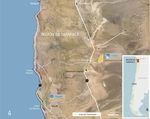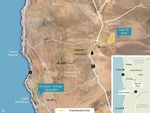Pumped storage in Chile - Bright prospects for - Valhalla
←
→
Page content transcription
If your browser does not render page correctly, please read the page content below
Pumped storage
Bright prospects for
pumped storage in Chile
The distinctive geological characteristics of the Atacama Desert in northern Chile are providing
ideal conditions for the construction and operation of an innovative pumped storage seawater
plant, alongside a solar photovoltaic project.
Co founders Juan Camus
and Francisco Torrealba.
Caleta San Marcos.
T
he Espejo de Tarapacá project (EDT) is ■ A 300MW hydroelectric seawater pumped The plants will be commercially integrated to
an innovative power project located in storage plant (the PSH plant) using the Pacific provide competitive, reliable and sustainable
northern Chile which combines natural Ocean as its lower reservoir and an existing electricity 24 hours a day, seven days a week.
solar and hydroelectric resources with proven natural concavity as its upper reservoir. EDT is one of the most innovative large-scale
generation technology. The project is comprised ■ An up to 600MW-AC solar photovoltaic plant infrastructure projects in the world, based on
of two commercially integrated power plants: (the PV plant) with single axis tracking. its unique integration of proven generation
technologies with renewable natural resources
Geo reference. to supply electricity 24/7. By combining Chile’s
natural resource characteristics with recent
reductions in the cost of photovoltaic solar
generation, EDT is able to provide a competitive,
reliable and sustainable alternative to traditional
electric generation. These natural characteristics
include: (i) the best solar irradiation in the world,
(ii) a coastal site with a steep cliff and a natural
surface concavity within a short distance, and
(iii) direct access to the Pacific Ocean, which
provides continuous water supply with no
hydrological volatility.
The project’s unique combination of solar
energy and pumped storage in Chile will resolve
the intermittency or limited availability problem
inherent to solar and wind technologies by
effectively combining the country’s abundant
sunlight and seawater resources to ensure
electricity availability 24/7, says the developers.
EDT’s pumped storage hydro plant is effectively
equivalent to a large renewable energy battery –
storing solar energy in the form of water which
is pumped into the reservoir to be stored until
required by the system.
36 INTERNATIONAL WATER POWER & DAM CONSTRUCTION April 2016Pumped storage
The map shows the location of both associated tunnels to the reservoir. Both the
plants and transmission lines. eastern and western reservoirs will be surrounded
by a dike with an average height of 3m and
completely lined with an impervious membrane
made of a highly resistant bituminous material to
prevent filtration. A separation dike will also be
constructed in the western reservoir to enhance
operating flexibility, allowing the project to store
reserves or perform maintenance in one half of
the reservoir while continuing to operate.
The PSH plant installations include reversible
pumping equipment located in an underground
powerhouse. As noted above, when the project
is dispatched on a relatively continuous basis,
during sun-hours, this equipment pumps water
from the ocean to the upper reservoir on top
of the coastal cliff, and during dark-hours, the
equipment generates electricity with the water
stored in the reservoir, which is released and
returned to the ocean. There will be a single
underground bi-directional water conduction
system comprised of the ocean intake and
tunnels, which will be used for the water flow in
both pumping and generating modes.
Founded in Stanford from the seawater intake point, serves as the The principal components of the PSH plant
The project’s founders, Juan Andres Camus and upper (storage) reservoir. Additionally, the include: (i) three 100MW Francis-type reversible
Francisco Torrealba, came up with the conceptual natural elevation of the cliff, 600m above sea turbines, along with 115 MVA transformers,
idea while completing post-graduate degrees level, provides the significant height differential (ii) a 350m subsea tunnel that ends in a sea
at Stanford University. Their ambition was to required for efficient hydroelectric generation. piercing system with an intake point depth of
design a storage system for their native Chile’s The project’s upper reservoir, which is approximately 16m, (iii) a 2200m underground
infinitely abundant renewable energy resources. comprised of the natural concavity located on water discharge tunnel, (iv) a 1150m access
Torrealba, who grew up in the Atacama Desert the top of the cliff, encompasses a total land area tunnel, (v) a 730m headrace tunnel, (vi) a vertical
in northern Chile, was familiar with the area’s of 375 hectares and energy storage capacity of steel lined pressure shaft with a height of 535m,
exceptional geographical characteristics, which 83GWh, respectively. When the reservoir is at full (vii) a 110m surge shaft at the top of the pressure
include an extensive coastline along the Pacific capacity, the PSH plant can generate electricity at shaft, (viii) a 150m surge chamber located
Ocean, a lofty coastal mountain range containing nominal capacity continuously for 11 days downstream of the power cavern, (ix) a 220kV
deep surface concavities within kilometres of The shaded area in the photograph below GIS substation, and (x) above-ground buildings
the ocean, and an arid, nearly cloudless inland shows the location of the upper reservoir, including a control room, plant office, warehouse
climate, home to the best irradiation conditions which is comprised of two bodies of water, an and desalinization plant (to provide water for
in the world. These distinctive characteristics, eastern and western reservoir which will be PSH plant construction and operations and to the
together with recent technological advancements interconnected via a canal with a distance of local community). The combined length of all
in photovoltaic solar generation which have 275m. The white line indicates the PSH plant’s tunnelling is approximately 5.5km.
yielded significant cost reductions, allow the waterways including the seawater intake and The PSH plant installations also include the
project to provide reliable and sustainable
renewable energy, which at the same time is
competitive with coal-fired generation.
Hydro in the world’s driest desert
Both the PSH and PV plants will be located
south of the closest major city of Iquique in the
Tarapacá Region of northern Chile. The PSH
plant will be located on the coast approximately
100km south of Iquique on a site that includes a
600m coastal cliff with a large natural concavity
on the surface. The PSH plant will connect
to the Lagunas substation in the northern
interconnected system known as SING, by means
of a new 65km transmission line.
The site geography presents ideal conditions
for the construction and operation of a PSH
plant. The Pacific Ocean serves as the lower
reservoir, providing an abundant and non-volatile
water supply. A natural concavity located on Upper reservoir of the pumped storage plant.
the surface of a steep coastal cliff, only 3km
April 2016 WWW.WATERPOWERMAGAZINE.COM 37Pumped storage
Layout of the pumped storage plant.
Reinvigorating clean energy
EDT is 100% owned by Valhalla, a
Chilean independent power company.
The company is focused on the
development, ownership and operation of
renewable power projects which utilise
Chile’s natural resources and strategically
diversify the country’s energy matrix
away from an overdependence on
imported fossil fuels. Valhalla is currently
in the process of inviting strategic
investors to participate as partners in the
ownership of the project.
Valhalla’s innovative project is
compatible with Chile’s energy goals.
Since March 2014, under the administration
of Minister of Energy, Maximo Pacheco,
Chile has focused on enhancing
competition, boosting the development of
non-conventional renewable energy,
reducing carbon emissions and improving
local development benefits provided by
energy projects to the local communities.
The government’s Energy Agenda and
Long Term Energy Policy has established a
target of 70% of power generation from
renewable sources by 2050.
Chile also became a founding member
in the group of visionary countries that
jointly launched the Mission Innovation
initiative announced at the United Nations
Conference on Climate Change in Paris in
November 2015. This advocates the
common goal “to reinvigorate and
accelerate public and private global clean
energy innovation with the objective to
make clean energy widely affordable.”
www.valhalla.cl
65km transmission line from the PSH plant to the feasibility site studies and engineering design. Transparent and inclusive relationship
Lagunas substation. The engineering design was performed by Poch The project has prioritised the establishment of
The PV plant site is a flat tract of land, Engineering and Skava Consulting under the an early, transparent and inclusive relationship
approximately 1000m above sea level comprised leadership and management supervision of with the local community. The PSH plant is
of 1568 hectares in the middle of the Tarapacá EDT’s Project Director. Several external experts adjacent to a fishing village with a population
Region of the Atacama Desert. The PV plant is were also engaged to analyse specific project of around 300 inhabitants. Interaction with
comprised of a 600MW-AC PV solar park which components. the community was initiated in 2012 in order
will be constructed in phases and will utilise a International consultants Norconsult and to address community concerns in early
single-axis tracking system in order to maximize Multiconsult were engaged to review and assess development. A formal work methodology
energy output by tilting the panels to follow the the underground works and PSH equipment, was implemented to assist the community
sun throughout the day from east to west. respectively, and detailed engineering for design with analysis of the project, which included
of the ocean intake was performed by specialised numerous working sessions, creation of a special
Project Status consulting firm, PRDW Consulting Port and commission and hiring of community advisors.
Since 2011, Valhalla has focused on critical Coastal Engineers. The results of the engineering In March 2015, collaboration agreements
development activities including engineering studies were used to prepare the EIA permit which govern the interaction with the community
and design, permitting, and community request and the tender documents to request during development, construction and
engagement. The project is currently at an contractor proposals for the PSH construction operation of the project were executed with two
advanced stage of development having achieved contracts. community organisations.
several important milestones such as approval The estimated project investment is
of the PSH and PV plant and transmission Permitting approximately US$1.3B. Plans are afoot to launch
line environmental permits, execution of The project has completed the environmental the financing process in the next few months in
collaboration agreements with community permitting process. The Environmental order to commence construction prior to the end of
organisations, and pre-selection of certain Impact Approval (EIA) for the PSH plant and the year. Total construction for the entire project,
construction contractors, among others. the corresponding transmission line was including the PSH and PV plants and transmission
unanimously approved by the authorities in lines, will be approximately 3.5 years. The PV
Engineering December 2015 and the EIA for the PV plant and plant will initiate operations in phases, starting in
EDT has performed extensive engineering associated transmission line was unanimously 2019. The PSH plant and all PV plant installations
work and studies for the PSH plant, including approved by the authorities in January 2016. are expected to be completed in 2020. ■
38 INTERNATIONAL WATER POWER & DAM CONSTRUCTION April 2016You can also read
























































